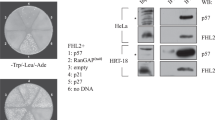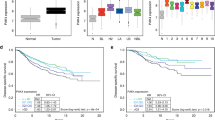Abstract
The activating protein-1 (AP-1) transcription factor transduces growth signals through signal transduction pathways to the nucleus, leading to the expression of genes involved in growth and malignant transformation in many cell types. We have previously shown that overexpression of a dominant negative form of the cJun proto-oncogene, a cJun dominant negative mutant (Tam67), blocks AP-1 transcriptional activity, induces a G1 cell cycle block and inhibits breast cancer cell growth in vitro and in vivo. We found that AP-1 blockade by Tam67 in MCF-7 breast cancer cells downregulates cyclin D1 transcriptional activity by at least two mechanisms: by suppressing transcription at the known AP-1 binding site (−934/−928) and by suppressing growth factor-induced expression through suppressing E2F activation at the E2F-responsive site (−726/−719). AP-1 blockade also led to reduced expression of E2F1 and E2F2, but not E2F4, at the mRNA and protein levels. Chromatin immunoprecipitation and supershift assays demonstrated that AP-1 blockade caused decreased binding of E2F1 protein to the E2F site in the cyclin D1 promoter. We also found that Tam67 suppressed the expression of the E2F1 dimerizing partner, DP1 and E2F-upregulated cell cycle genes (cyclins E, A, B and D3) and enhanced the expression of E2F-downregulated cell cycle genes (cyclins G2 and I). Reduced expression of other E2F-regulated genes was also seen with AP-1 blockade and E2F suppression. Thus, the AP-1 factor regulates the expression of cyclin D and E2F (the latter in turn regulates E2F-downstream genes), leading to cell cycle progression and breast cancer cell proliferation.
This is a preview of subscription content, access via your institution
Access options
Subscribe to this journal
Receive 50 print issues and online access
$259.00 per year
only $5.18 per issue
Buy this article
- Purchase on Springer Link
- Instant access to full article PDF
Prices may be subject to local taxes which are calculated during checkout









Similar content being viewed by others
Abbreviations
- AP-1:
-
activating protein-1
- ChIP:
-
chromatin immunoprecipitation
- Dox:
-
doxycycline
- EMSA:
-
electrophoretic mobility shift assay
- ER:
-
estrogen receptor
- NE:
-
nuclear extract
- RPA:
-
RNase protection assay
- Tam67:
-
a cJun dominant-negative mutant
References
Angel P, Karin M . (1991). The role of Jun, Fos and the AP-1 complex in cell-proliferation and transformation. Biochim Biophys Acta 1072: 129–157.
Botz J, Zerfass-Thome K, Spitkovsky D, Delius H, Vogt B, Eilers M et al. (1996). Cell cycle regulation of the murine cyclin E gene depends on an E2F binding site in the promoter. Mol Cell Biol 16: 3401–3409.
Brown PH, Alani R, Preis LH, Szabo E, Birrer MJ . (1993). Suppression of oncogene-induced transformation by a deletion mutant of c-jun. Oncogene 8: 877–886.
Bu X, Avraham HK, Li X, Lim B, Jiang S, Fu Y et al. (2005). Mayven induces c-Jun expression and cyclin D1 activation in breast cancer cells. Oncogene 24: 2398–2409.
Chen TK, Smith LM, Gebhardt DK, Birrer MJ, Brown PH . (1996). Activation and inhibition of the AP-1 complex in human breast cancer cells. Mol Carcinog 15: 215–226.
DeGregori J, Kowalik T, Nevins JR . (1995). Cellular targets for activation by the E2F1 transcription factor include DNA synthesis- and G1/S-regulatory genes. Mol Cell Biol 15: 4215–4224.
Dimova DK, Dyson NJ . (2005). The E2F transcriptional network: old acquaintances with new faces. Oncogene 24: 2810–2826.
Donnellan R, Chetty R . (1998). Cyclin D1 and human neoplasia. Mol Pathol 51: 1–7.
Gee JM, Barroso AF, Ellis IO, Robertson JF, Nicholson RI . (2000). Biological and clinical associations of c-jun activation in human breast cancer. Int J Cancer 89: 177–186.
Han S, Park K, Bae BN, Kim KH, Kim HJ, Kim YD et al. (2003). E2F1 expression is related with the poor survival of lymph node-positive breast cancer patients treated with fluorouracil, doxorubicin and cyclophosphamide. Breast Cancer Res Treat 82: 11–16.
Herber B, Truss M, Beato M, Muller R . (1994). Inducible regulatory elements in the human cyclin D1 promoter. Oncogene 9: 2105–2107.
Johnston SR, Lu B, Scott GK, Kushner PJ, Smith IE, Dowsett M et al. (1999). Increased activator protein-1 DNA binding and c-Jun NH2-terminal kinase activity in human breast tumors with acquired tamoxifen resistance. Clin Cancer Res 5: 251–256.
Lavia P, Jansen-Durr P . (1999). E2F target genes and cell-cycle checkpoint control. Bioessays 21: 221–230.
Liu Y, Lu C, Shen Q, Munoz-Medellin D, Kim H, Brown PH . (2004). AP-1 blockade in breast cancer cells causes cell cycle arrest by suppressing G1 cyclin expression and reducing cyclin-dependent kinase activity. Oncogene 23: 8238–8246.
Liu Y, Ludes-Meyers J, Zhang Y, Munoz-Medellin D, Kim HT, Lu C et al. (2002). Inhibition of AP-1 transcription factor causes blockade of multiple signal transduction pathways and inhibits breast cancer growth. Oncogene 21: 7680–7689.
McDonnell SE, Kerr LD, Matrisian LM . (1990). Epidermal growth factor stimulation of stromelysin mRNA in rat fibroblasts requires induction of proto-oncogenes c-fos and c-jun and activation of protein kinase C. Mol Cell Biol 10: 4284–4293.
Muller H, Helin K . (2000). The E2F transcription factors: key regulators of cell proliferation. Biochim Biophys Acta 1470: M1–M12.
Shah S, Pishvaian MJ, Easwaran V, Brown PH, Byers SW . (2002). The role of cadherin, beta-catenin, and AP-1 in retinoid-regulated carcinoma cell differentiation and proliferation. J Biol Chem 277: 25313–25322.
Shang Y, Hu X, DiRenzo J, Lazar MA, Brown M . (2000). Cofactor dynamics and sufficiency in estrogen receptor-regulated transcription. Cell 103: 843–852.
Shen F, Fan X, Liu B, Jia X, Du H, You B et al. (2006a). Overexpression of cyclin D1-CDK4 in silica-induced transformed cells is due to activation of ERKs, JNKs/AP-1 pathway. Toxicol Lett 160: 185–195.
Shen Q, Singh P . (2004). Identification of a novel SP3 binding site in the promoter of human IGFBP4 gene: role of SP3 and AP-1 in regulating promoter activity in CaCo2 cells. Oncogene 23: 2454–2464.
Shen Q, Zhang Y, Uray IP, Hill JL, Kim HT, Lu C et al. (2006b). The AP-1 transcription factor regulates postnatal mammary gland development. Dev Biol 295: 589–603.
Smith LM, Wise SC, Hendricks DT, Sabichi AL, Bos T, Reddy P et al. (1999). cJun overexpression in MCF-7 breast cancer cells produces a tumorigenic, invasive and hormone resistant phenotype. Oncogene 18: 6063–6070.
Szabo E, Preis LH, Brown PH, Birrer MJ . (1991). The role of jun and fos gene family members in 12-O-tetradecanoylphorbol-13-acetate induced hemopoietic differentiation. Cell Growth Differ 2: 475–482.
Yamasaki L . (1998). Growth regulation by the E2F and DP transcription factor families. Results Probl Cell Differ 22: 199–227.
Zhang SY, Liu SC, Al-Saleem LF, Holloran D, Babb J, Guo X et al. (2000). E2F-1: a proliferative marker of breast neoplasia. Cancer Epidemiol Biomarkers Prev 9: 395–401s.
Acknowledgements
We thank Shirley Pennington for her assistance in preparing this manuscript. This work was supported by a pilot grant from the Dan L Duncan Cancer Center at Baylor College of Medicine.
Author information
Authors and Affiliations
Corresponding author
Rights and permissions
About this article
Cite this article
Shen, Q., Uray, I., Li, Y. et al. The AP-1 transcription factor regulates breast cancer cell growth via cyclins and E2F factors. Oncogene 27, 366–377 (2008). https://doi.org/10.1038/sj.onc.1210643
Received:
Revised:
Accepted:
Published:
Issue Date:
DOI: https://doi.org/10.1038/sj.onc.1210643



